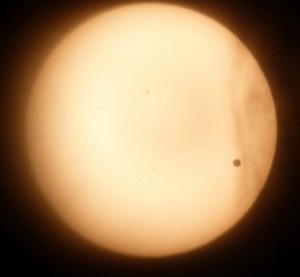
Intrepid star-gazers were rewarded with a rare glimpse of Venus against the setting sun on Tuesday at the SUNY Oneonta Observatory. The college’s Department of Physics and Astronomy hosted a public viewing of the transit of Venus — an event that only occurs roughly twice every century —using telescopes fitted with solar filters.
The evening began with a solid cloud deck and rain, but by 6 p.m., the rain had stopped and the clouds had slightly thinned. “By that point, we had five or six people from the community in the observatory waiting for the weather to clear,” said Dr. Jason Smolinski, assistant professor of Physics & Astronomy. At about 6:10, the clouds thinned and the disk of the sun became visible. “Quickly, we pointed the 14-inch telescope at it and were greeted with a view showing Venus approximately halfway through its `entrance’ into the solar disk. It looked like a dark dimple in the edge of the sun,” Smolinski said.
The view lasted only a few minutes, however, as the clouds thickened, obscuring the sun. Joined by new arrivals, the group waited for more than an hour, watching as small gaps in the clouds passed by outside the vicinity of the sun. At about 7:20 p.m., they were rewarded with another break in the clouds — but by then the sun was so low that trees obstructed it from observatory viewing.
Smolinski grabbed a smaller, 4.5-inch telescope with a solar filter, and the group raced across the grassy lawn to a point where the sun was visible. The clouds remained thin enough to see the transit clearly while the group of roughly 15 people, including several children, took turns looking through the small scope.
“Part of the excitement was that `thrill of the hunt’ feeling from waiting and then pursuing with the small telescope in hand,” Smolinski said. “Another part of the excitement came from being able to witness an event that won’t occur for another 105 years. However, I think the greatest satisfaction for me was being able to see people from the community come up to our observatory in the hopes of seeing the transit, be rewarded for their diligence, and walk away feeling like it had been worth the wait.”
Located at SUNY Oneonta’s 280-acre College Camp facility on the northeastern side of campus, the college observatory is home to the largest optical telescope in New York state.

